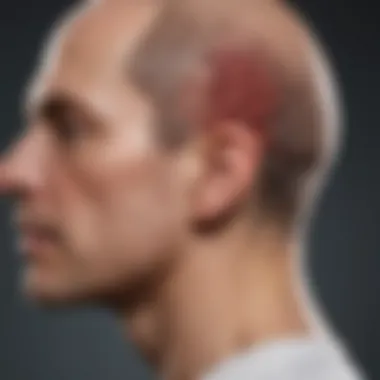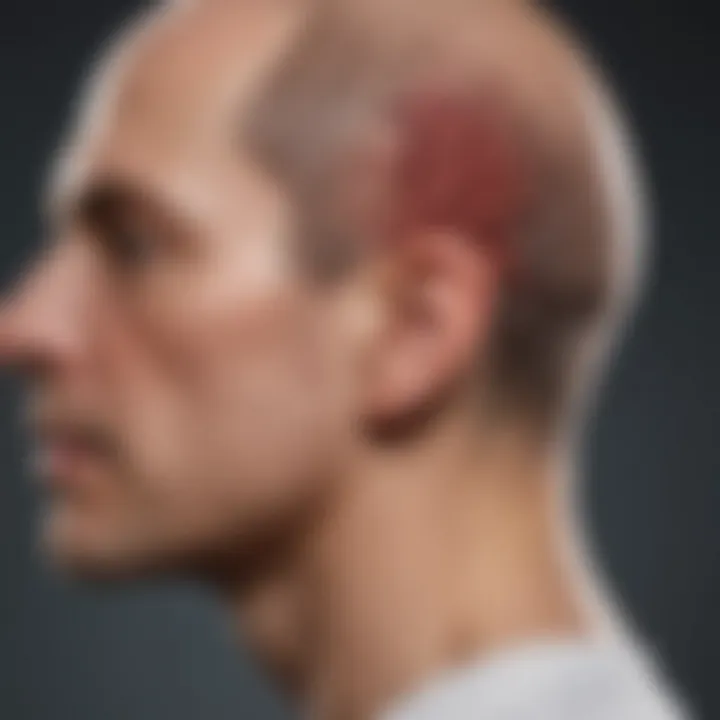Exploring Itchiness at the Back of the Head


Intro
Itchiness at the back of the head is a nuanced topic that often gets overlooked in discussions around skin irritations and discomfort. This localized irritation can be more than just an annoying sensation; it can signal underlying issues ranging from dermatological conditions to lifestyle stressors that inadvertently affect our health. Understanding what contributes to this itchiness is essential, not only for alleviating immediate discomfort but also for addressing any deeper health concerns that may lie beneath the surface.
In this guide, we will delve into various causes of itchiness in this specific area, parameterizing them into manageable categories. We will discuss accompanying symptoms and the ways in which they manifest. Additionally, this article will cover diagnostic approaches utilized by health professionals and present preventive measures and effective management strategies. As we navigate through this topic, our goal is to provide insights that empower readers to pay closer attention to their body’s signals, ultimately promoting personal well-being and health awareness.
What Is Itchiness at the Back of the Head?
Itchiness at the back of the head can be a frustrating experience, often overlooked but significant enough to warrant attention. Understanding this localized itch is essential, as it can serve as a signal for underlying health issues or trigger essential lifestyle changes. Many people may dismiss these sensations as mere annoyances, yet they might indicate larger problems that need addressing. This exploration into the causes, symptoms, and potential solutions will help illuminate why this specific location on the scalp deserves a closer look.
Defining Itchiness
Itchiness, also known as pruritus, is a noticeable and often unpleasant sensation that prompts a desire to scratch. While it might seem trivial, it can reveal a lot about one’s health. Itching occurs when nerve endings in the skin become irritated. This irritation can be due to a variety of reasons, some of which can be benign, while others may require urgent care. Scratching the itch might provide temporary relief but can also lead to skin damage or infections, which might complicate an otherwise simple issue.
Significance of Location
The back of the head is a particularly intriguing area when it comes to itchiness. This part of the scalp can be susceptible to numerous irritants, both external and internal. Locations on the body can play a role in diagnosing certain conditions; the back of the head may differ in itchiness based on factors like:
- Hair Products: Users of shampoos, conditioners, or styling products may find that their formulations irritate the skin in this area more than others. Ingredients such as sulfates or fragrances can cause reactions.
- Sweat and Hygiene: The back of the head often traps sweat and moisture, making it a breeding ground for bacteria or fungi. This can lead to discomfort and increased itchiness.
- Dermatological Conditions: Conditions like dandruff or seborrheic dermatitis frequently manifest as itchiness specifically in this region.
"Itchiness, especially at the back of the head, could be the body’s way of signaling the need for a change—be it in products used or lifestyle approaches."
Understanding the significance of itchiness at the back of the head not only helps in addressing immediate comforts but also guides individuals towards broader reflections on their health and well-being. As we delve deeper into the potential causes, symptoms, and solutions, we’ll begin to piece together a more comprehensive picture of this often-dismissed sensation.
Potential Causes
When it comes to understanding the prickly sensation at the back of the head, exploring the potential causes is essential. Knowing what's behind the itch can help individuals take the right steps toward relief. The itchiness may be a symptom of something minor, like dry skin, or a sign of a more serious issue, such as an underlying health condition. Each cause has its own particularities which deserve careful examination to help effectively address the issue and avoid further discomfort.
Dermatological Conditions
Dandruff
Dandruff is often a leading offender when it comes to itchy scalp problems. It boils down to flaking of the skin, which can be particularly troublesome for folks who experience itchiness at the back of the head. The key characteristic here is that dandruff generally appears as white flakes on the scalp, which can easily be noticed on dark clothing.
One of the beneficial aspects of recognizing dandruff is that it’s usually an easy fix. Over-the-counter shampoos containing zinc pyrithione or ketoconazole effectively treat this condition, allowing individuals to get back to their daily lives without needing to constantly scratch their heads. However, one unique feature of dandruff is its tendency to return if not managed with a proper skincare routine.
Seborrheic Dermatitis
Seborrheic dermatitis takes things a step further, as it involves inflamed, flaky patches on the scalp. This condition can lead to intense itching, especially at the back of the head, making it uncomfortable. The hallmark of seborrhea is the oily appearance of the flakes, which sets it apart from regular dandruff.
This condition is considered beneficial for this article because it highlights the importance of proper diagnosis. Identifying seborrheic dermatitis prompts individuals to explore medical options such as antifungal creams, which can tackle the underlying yeast often responsible for exacerbating the condition.
Psoriasis
Psoriasis, known for its thick and red patches covered in silvery scales, can also contribute to irritation at the back of the head. Its crux lies in the rapid turnover of skin cells, which leads to an accumulation that can become itchy and irritating.
The distinctive feature of psoriasis is its chronic nature. Unlike dandruff or seborrheic dermatitis, psoriasis is often linked to genetic factors and an overactive immune system. Understanding this condition is helpful as it underscores the need for ongoing management strategies, potentially including topical treatments and lifestyle changes.
Allergic Reactions
Contact Dermatitis
Contact dermatitis can occur when an irritant or allergen comes into contact with the skin on the back of the head. This can include a variety of products such as hair dyes, shampoos, or even soaps. The main characteristic of contact dermatitis is that it's localized, which means the itchiness often matches the area of contact, making it easier to identify the cause.
The benefit of acknowledging this condition is that it encourages individuals to assess their personal care routines. Identifying a specific product that triggers this reaction can lead to quick relief by discontinuing its use. However, one challenge is that some individuals may not realize they've developed a sensitivity over time, leading to ongoing discomfort.
Food Allergies
Food allergies can also complicate the situation. In some cases, itchiness at the back of the head can be a delayed reaction to something consumed. This can make it tricky to pinpoint. The central aspect to consider is that food allergies often provoke systemic symptoms, meaning the itch might not be isolated to just one area.
This condition is significant for this article because it emphasizes the importance of awareness regarding food intake. Keeping a food diary might uncover patterns over time, though it can take a while to connect symptoms with specific dietary choices.
Stress and Anxiety
Stress and anxiety can play a notable role in exacerbating itchiness at the back of the head. The body's reaction to stress can lead to an increase in certain skin conditions or even trigger outbreaks in existing issues. The psychological effects may manifest physical symptoms that may not be directly linked to an identifiable cause; rather, they are a reaction to overwhelming feelings or pressures.
Infections
Fungal Infections
Fungal infections present a more serious cause of itchiness at the back of the head. Conditions like tinea capitis, or scalp ringworm, can lead to significant discomfort. The telltale sign of a fungal infection is often a circular patch of itchy, scaly skin, which can be distressing both physically and aesthetically.
The importance lies in understanding that this type of infection usually requires medical intervention, such as antifungal medications, to resolve effectively. The unique aspect of fungal infections is that they can spread, emphasizing the need for prompt treatment.
Bacterial Infections
Bacterial infections can also lead to localized itching and irritation. Conditions such as folliculitis may occur when hair follicles become infected, leading to red, itchy bumps that can occasionally resemble acne.


Highlighting bacterial infections brings attention to the potential seriousness of the issue. While some may dismiss initial symptoms as minor, understanding that bacterial infections may require antibiotics underscores why it’s crucial to pay attention to uncomfortable sensations and changes in the scalp.
Internal Health Issues
Hormonal Imbalances
Hormonal imbalances can manifest as dry, itchy skin, including the back of the head. Hormones play a significant role in skin health, and fluctuations can lead to a myriad of skin concerns including itchiness. Recognizing this aspect encourages individuals to consider their overall health and wellness, making it beneficial in the context of this article.
The unique feature about hormonal imbalances is that they can be temporary or chronic, depending on lifestyle, health conditions, or age. This emphasizes the need for consultation with a healthcare professional if persistent itchiness is noted.
Autoimmune Disorders
Autoimmune disorders can complicate skin irritations as the body mistakenly attacks its own cells, leading to conditions such as lupus or alopecia areata. These disorders sometimes present with symptoms of itchiness as a part of a broader spectrum of issues.
The significance of autoimmune disorders is that they can be tricky to diagnose and require specialized management. This highlights why understanding potential underlying health concerns is crucial in addressing the itchiness at the back of the head.
Symptoms Associated with Itchiness
Understanding the symptoms linked with itchiness at the back of the head is crucial for anyone experiencing this discomfort. This section presents a nuanced view of physical symptoms, such as redness, swelling, and flaky skin, along with the psychological implications, particularly how these symptoms can affect one's mental health and daily life. Recognizing these symptoms not only aids in the diagnosis but also helps in tailoring appropriate management strategies that can lead to more effective relief.
Physical Symptoms
Redness
Redness at the back of the head can be one of the most apparent signs of irritation. When the skin becomes inflamed, it turns red due to increased blood flow to the area, which happens as the body responds to harmful stimuli, whether they stem from an allergic reaction, infection, or other causes. This bright hue serves as a visual indicator that something isn't quite right, prompting individuals to pay closer attention.
Key characteristics of redness include its visibility and often accompanying sensations like warmth or tenderness. These features make it a significant topic within the broader conversation about itchiness. In this article, noting redness helps underscore underlying issues that may be manifesting. However, while it draws attention to the irritation, it might not always signal a severe condition but rather a localized response.
Advantageously, recognizing redness can push individuals toward seeking immediate treatment; on the downside, its presence might ignite anxiety, as some might fear it signals a larger issue.
Swelling
Swelling often goes hand in hand with redness, sometimes making a bad combo for those struggling with itchiness. This puffiness occurs as fluid gathers in the tissues, typically due to inflammation. In the context of itchiness at the back of the head, swelling can be a direct result of a range of conditions from allergic reactions to infections.
The key feature of swelling is its palpable nature; affected areas feel full or tight, which can lead to discomfort beyond just itchiness. It’s vital to mention swelling here as it signals the body’s attempt to heal or respond to injury or irritants. While it draws attention to the severity of an issue, persistent swelling can become a burden, severely affecting one’s quality of life and capacity to concentrate on daily tasks.
Flaky Skin
When the skin starts to flake, it often points to something deeper going on. Flaky skin, often coupled with itchiness, can arise from conditions like seborrheic dermatitis or psoriasis. This symptom illustrates a breakdown of the skin barrier, leading to dry patches that can cause discomfort and even embarrassment.
The characteristic of flaky skin is its texture; it can vary from fine, powdery particles to larger, more pronounced scales. Discussing flaky skin is essential because it tends to draw immediate concern—who wants to deal with skin that looks like it’s shedding? For those affected, understanding its causes can unlock potential treatment paths. However, it's worth noting the emotional impact that flaky skin can have on self-esteem, adding another layer to the itchiness experience.
Psychological Effects
Impact on Mental Health
The impact of itchiness, especially at the back of the head, can ripple beyond mere physical discomfort. Itches can lead to stress, anxiety, and even depression, often bending the mind under the weight of relentless irritation. When a person is constantly scratching or feeling uneasy about their condition, it can manifest in mental fatigue and irritability, impairing daily functioning.
What makes this a central point in our discussion is the interconnectedness of physical and mental wellbeing. The struggle with chronic itchiness doesn't only affect skin health; it tarnishes overall quality of life. Addressing itchiness necessitates a multi-faceted approach, not only handling the physical symptoms but also caring for the mental state that can suffer in silence.
Distraction in Daily Life
Itchy sensations can become an unwelcome guest in day-to-day activities. The distraction that stems from persistent itchiness can break one’s focus, making it really hard to concentrate on anything. Whether at work or social gatherings, the constant urge to scratch pulls attention away, often causing frustration.
The key characteristic of this distraction is its subtlety; it can steal moments without one realizing it, leading to a conundrum where both mind and body feel worn out. This distraction is particularly relevant in workplace dynamics as it can hinder productivity and creativity. Although one might think of itchiness as a minor annoyance, its cumulative effect can significantly disrupt various aspects of life.
The uniqueness of this distraction is that it highlights an ongoing cycle—itchiness leads to distraction, which in turn can increase stress levels, further exacerbating the itch, and so forth. By recognizing this cycle, individuals can be empowered to seek help, regain control, and restore their concentration on what truly matters.
Diagnostic Approach
Understanding the diagnostic approach to itchiness at the back of the head is crucial for determining the underlying causes and subsequently guiding effective treatments. By employing a structured method for diagnosis, healthcare providers can pinpoint the specific nature of the itchiness, whether it is due to a dermatological condition, allergic reaction, stress, infection, or an internal health issue. This phase serves not only as a means to identify the problem but also as a way to rule out other possible health concerns that may present similarly.
Medical History Review
The medical history review is a cornerstone of the diagnostic process. Here, practitioners assess previous health records, treatments, and any related symptoms that the patient may have experienced. Questions posed may include:
- Have you had similar itchiness before?
- Are there any allergies you are aware of?
- Have you changed any personal care products recently?
This stage helps to create a comprehensive picture of the person’s skin health and aids in narrowing down potential causes. By understanding the context of the patient's health, physicians can make more informed decisions regarding next steps in the diagnostic process.
Physical Examination
During a physical examination, the healthcare professional inspects the scalp and surrounding areas for visible signs of irritation or infection. This could involve looking for:
- Rashes or redness
- Scales or flakes
- Hair loss
The manner in which the skin reacts can also give clues about the condition causing itchiness. For example, swelling and redness usually point towards inflammation, while flaky skin might suggest dryness or a fungal issue. This step is essential in forming a visual assessment that complements the medical history.
Laboratory Tests
In certain cases, laboratory tests are warranted to further investigate the causes of itchiness. Two common types of tests include skin scraping and allergy testing.
Skin Scraping
Skin scraping is a diagnostic procedure that involves collecting skin from the affected area to examine under a microscope. This method is particularly beneficial in ruling out fungal infections, as it can reveal the presence of organisms causing the irritation. A unique feature of skin scraping is that it's a non-invasive procedure and can be done quickly in a dermatological setting. However, it's essential to note that while skin scraping can provide vital information, it doesn’t address underlying conditions like allergies or systemic issues, which may need further testing.
Allergy Testing
Allergy testing entails identifying specific allergens that may trigger itchiness. This can be executed through skin tests or blood tests, helping determine if the itchiness relates to an allergic reaction — possibly from hair care products or certain foods. A key characteristic of allergy testing is its thoroughness; it examines multiple potential allergens at once, providing a broader understanding of what might be causing discomfort. Nonetheless, one must consider that testing can sometimes yield false positives, which might misdirect treatment and lead to confusion in the management of symptoms.
In summary, a strong diagnostic approach, inclusive of medical history reviews, physical examinations, and laboratory tests like skin scraping and allergy testing, can significantly enhance the understanding and treatment of itchiness at the back of the head.


By carefully analyzing these components, individuals can take the first step toward relief from this uncomfortable condition, gaining valuable insights into their personal health needs.
Preventive Measures
Preventive measures are crucial when it comes to managing itchiness at the back of the head. Addressing the issue before it worsens can save individuals from unnecessary discomfort and potential complications. It's not just about treating the symptoms after the fact; rather, establishing preventive routines and strategies can lead to a healthier scalp and overall well-being.
Skincare Routines
Maintaining a proper skincare routine specifically targets the health of the scalp and mitigates itchiness.
Moisturizing Techniques
Moisturizing techniques play an integral role in maintaining scalp hydration. A well-moisturized scalp is less prone to irritation and dryness, which can often trigger itching. The key characteristic of these techniques is that they effectively replenish the skin's moisture barrier, preventing flakes and consultation. For example, using gentle cleansers followed by appropriate moisturizers can significantly soothe the skin on the back of the head.
One unique feature of moisturizing techniques is their ability to adapt; they can be tailored to different skin types, be it oily or dry. The main advantage here is the personalized approach it offers but one must also tread carefully as over-moisturizing can lead to oiliness and adverse reactions, especially if paired with heavy products.
Choosing the Right Products
Choosing the right products is essential to a successful skincare routine. With a plethora of shampoos, conditioners, and scalp treatments on the market, it's crucial to identify ones formulated for specific needs. The significant aspect of choosing these products is focusing on hypoallergenic and non-irritating formulations. These options can assist in alleviating itchiness and promoting a calm scalp.
What makes this practice stand out is its proactive nature. If your selected product contains soothing ingredients like aloe vera or chamomile, it can play a significant role in reducing inflammation. Conversely, picking the wrong product – perhaps one with harsh chemicals – may exacerbate the situation. Careful consideration goes a long way.
Stress Management
Stress management is another vital preventive measure when it comes to itchiness at the back of the head. Stress can be a hidden perpetrator, manifesting itself in physical symptoms, including itchiness. Extra care should be taken in daily routines to manage stress effectively.
Meditation
Meditation is a powerful tool in stress management. Its impact on mental clarity and calmness can indirectly alleviate itchiness by reducing stress levels. The emphasis here lies in mindfulness, which helps people become aware of their thoughts and feelings without becoming overwhelmed. This practice tells the brain to relax, which could keep the physical body from reacting so strongly.
The unique feature of meditation is its accessibility. One does not need special equipment or a lot of time; just a quiet space and patience can suffice. The advantages of this technique far outweigh any potential downsides, provided one remains consistent. However, beginners may find it challenging to maintain focus at first. With practice, its effectiveness in calming the mind becomes apparent.
Physical Activity
Physical activity is another cornerstone of successful stress management. Regular exercise releases endorphins, which elevate mood and reduce feelings of stress. The key characteristic is not necessarily engaging in intense workouts; even a brisk walk or yoga can work wonders.
What sets physical activity apart as beneficial is its capability to be tailored to fit individual preferences. Some may enjoy hiking while others may prefer swimming. However, one thing remains clear: incorporating movement regularly can yield significant mental benefits. The challenge lies in consistency; many find it difficult to maintain a regular activity level in a busy schedule.
In summary, both skincare routines and stress management play a pivotal role in preventing itchiness at the back of the head. By establishing effective moisturization strategies, selecting appropriate products, managing stress through meditation, and engaging in physical activity, individuals can create a comprehensive preventive approach.
Management Strategies
Managing itchiness at the back of the head involves a multifaceted approach. The right strategies can not only alleviate discomfort but also prevent further irritation. Effective management can enhance one's quality of life by minimizing daily distractions and improving overall well-being. Incorporating topical treatments and home remedies helps to create a tailored routine that addresses the individual’s specific needs, providing relief efficiently and safely.
Topical Treatments
Corticosteroids
Corticosteroids represent a powerful class of anti-inflammatory medications used to treat skin issues, including itchiness at the back of the head. These treatments work by reducing inflammation and suppressing the immune response. A key characteristic of corticosteroids is their potent anti-itch properties, making them a commonly preferred choice in dermatology.
The unique feature of corticosteroids lies in their cumulative effectiveness; they can be applied topically to the affected area and often provide quick relief from uncomfortable symptoms. However, prolonged use can lead to potential side effects such as skin thinning. Therefore, healthcare professionals typically recommend limiting their use and carefully monitoring skin response.
Antihistamines
Antihistamines are another valuable resource for managing itchiness, especially when allergic reactions are a potential cause. These medications work by blocking histamine, a substance in the body that triggers allergic symptoms, including itchiness. The key characteristic of antihistamines is their ability to reduce itch while also promoting sleep, as some forms can induce drowsiness.
Antihistamines have the added advantage of being available over the counter, making them accessible for many. However, non-drowsy options are also available for individuals who need to stay alert. On the flip side, some people may experience dryness or increased sedation, making it essential to choose the right formulation based on individual needs.
Home Remedies
Essential Oils
Essential oils are gaining traction as a natural remedy for various skin irritations, including itchiness at the back of the head. Oils such as tea tree or lavender have been praised for their soothing properties and potential antimicrobial effects. Their main appeal is that they often come with fewer side effects compared to synthetic treatments.
The unique feature of essential oils is their versatility, as they can be blended with carriers and applied directly or diffused in the air. A potential downside is that some individuals may exhibit sensitivities or allergies to certain oils. Thus, it's wise to perform patch tests before widespread application.
Natural Creams
Natural creams often serve as a gentle alternative to medicated products, focusing on soothing and hydrating the skin. Many creams comprise natural ingredients, like aloe vera and shea butter, which have long been noted for their beneficial properties in skincare. These products aim to moisturize the skin and create a protective barrier against irritants.
One notable advantage is their broad applicability; they can be used daily without the worry of side effects commonly found in traditional treatments. However, the effectiveness may vary based on the individual's skin type and the underlying cause of the itchiness, leading some to require a more aggressive treatment plan.
When tackling itchiness at the back of the head, understanding the balance between treatments is crucial. Always consider consulting a healthcare professional before starting a new regimen.
Ultimately, implementing a combination of topical treatments and home remedies can lead to a balanced, effective strategy for managing itchiness, paving the way for better skin health and comfort.
When to Seek Professional Help


Recognizing when to seek professional help for itchiness at the back of the head is crucial for effective management. Ignoring prolonged discomfort could lead to aggravation of underlying issues or unnecessary complications. Consulting a healthcare professional ensures that the approach to treatment is safe and tailored to individual needs.
Persistent Symptoms
If you find yourself scratching or rubbing the back of your head persistently, it might be time to consult a doctor. This kind of relentless itchiness often signals that something is amiss—like an untreated skin condition or an allergic reaction that stubbornly keeps showing up. There's a lot of truth in the saying "better safe than sorry." Keeping an eye on symptoms is essential, especially if they linger beyond a week despite home remedies or over-the-counter treatments.
Persistent itchiness can sometimes be the quiet precursor to dermatological concerns like dermatitis or scalp psoriasis. Each of these conditions can lead to more severe skin issues if left unchecked. If your scalp's starting to look red, flaky, or even swollen, that’s a telltale sign it’s time to book an appointment with a dermatologist.
Persistent symptoms could indicate a much deeper issue. Don't wait too long to seek help — your health is worth it.
Severe Reactions
In some cases, itchiness at the back of the head can manifest with alarming intensity, leading to severe reactions like swelling, painful blisters, or signs of a serious allergic response. If you notice extreme discomfort or skin reactions that interfere with your daily activities, it’s a clear signal that quick medical intervention is necessary.
Severe allergic reactions, often caused by irritants like hair dyes or skin products, can escalate swiftly, presenting symptoms such as difficulty breathing or swelling beyond the itchy spot. Having these symptoms necessitates immediate medical attention.
To protect your overall well-being, consider making a note of when the reactions occur and what triggers them. This information can provide valuable insights to your healthcare provider regarding the next steps.
By keeping these considerations in mind, individuals can effectively manage itchiness at the back of their heads, promoting a proactive approach towards personal health.
The Role of Lifestyle in Managing Itchiness
Managing itchiness, particularly at the back of the head, often hinges on lifestyle choices that can significantly influence overall skin health and well-being. This section explores crucial elements that affect itchiness, diving into dietary and environmental factors, which are, more often than not, overlooked in discussions surrounding itchiness.
Dietary Considerations
Anti-Inflammatory Foods
Anti-inflammatory foods play a vital role in reducing itchiness. These foods, such as fatty fish rich in omega-3 fatty acids, berries with antioxidants, and leafy greens, help moderate inflammatory processes in the body. When inflammation is kept in check, it aids in preventing flare-ups of conditions that may lead to itching.
A key characteristic of these foods is that they help nourish the skin from the inside out. They bolster the body’s defense against free radicals and other harmful agents, which can cause irritation or exacerbate existing conditions. Incorporating a balanced variety of these foods into one’s diet stands out as a beneficial choice for managing itchiness.
One unique feature of anti-inflammatory foods is their ability to promote gut health. A healthier gut can improve nutrient absorption and support immune function, which can be particularly advantageous for individuals dealing with itchiness, due to the interplay between skin health and gut microbiota.
However, it’s important to note that not everyone's body reacts the same way to certain foods. Some individuals may experience digestive issues with foods they previously enjoyed, which could lead to new skin irritations. Thus, awareness of one's own dietary responses is essential.
Hydration
Hydration is another cornerstone that cannot be understated. Keeping the body well-hydrated supports skin elasticity and function, which helps prevent dryness and itching. Water aids in the transportation of nutrients and the elimination of toxins, both crucial for maintaining skin health.
A key characteristic of proper hydration is its simplicity yet profound impact. Adequate water intake can enhance the skin’s barrier function and lead to an overall healthier skin appearance. Therefore, drinking enough water is a popular and accessible strategy for anyone looking to alleviate itchiness.
Unique to hydration is how external factors can also play a role. For example, high temperatures or exhaustive physical activity can lead to rapid dehydration, increasing the risk of dry skin and resultant itching. To maintain balance, it’s crucial to be mindful of one’s fluid intake throughout the day.
Environmental Factors
Humidity Levels
Humidity levels significantly influence skin condition and itchiness experienced at the back of the head. In environments with low humidity, skin tends to dry out more quickly, leading to irritation and itchiness. Conversely, moderate humidity can help keep skin hydrated.
The key characteristic of humidity is its capacity to affect skin moisture levels. Higher humidity can support a balanced moisture content in the skin, helping to fend off dryness that can cause itching. This makes monitoring local humidity conditions a beneficial choice for those sensitive to environmental fluctuations.
A unique aspect of humidity is the need for balance. Excessively high humidity can also lead to fungal and bacterial growth, potentially causing infections that heighten itchiness, especially in sensitive areas like the scalp. Thus, understanding the local climate conditions and one's own comfort levels is important.
Air Quality
Finally, air quality plays a substantial role in managing itchiness. Poor air quality, often marked by pollutants and allergens, can exacerbate skin reactions and contribute to itchiness. Exposure to pollutants like smoke, dust, and pet dander triggers inflammatory responses in the skin.
A key characteristic of air quality is its direct connection to overall well-being. Clean air supports a healthier living environment, drastically reducing the likelihood of irritating skin conditions. Thus, improving air quality is an essential and popular choice for those aiming to alleviate itchiness.
The unique feature of air quality is its dual nature; while some sources of irritation are external, maintaining clean and fresh air indoors can become a safe haven for those affected. This may include using air purifiers or regularly cleaning living spaces to minimize allergen exposure.
Understanding the intersection of lifestyle choices with itchiness creates a comprehensive framework for managing this frustration. Through dietary choices, hydration, and attention to environmental factors, individuals can empower themselves to minimize itchiness and enjoy improved comfort.
End
In encapsulating the topic of itchiness at the back of the head, it becomes evident that understanding the underlying causes and manifestations of this phenomenon is crucial for managing it effectively. Through a thorough exploration of the potential triggers, including dermatological conditions and environmental factors, readers gain a clearer picture of what might be fueling their discomfort. Furthermore, it's not just about recognizing the symptoms; it’s also about considering the broader implications of persistent itchiness that may affect one’s daily living.
The importance of preventive measures cannot be overstated. Simple lifestyle adjustments such as adopting appropriate skin care routines or adjusting dietary habits may significantly alleviate symptoms before they escalate.
Additionally, one must recognize the emotional toll that itchiness can bring. This isn't merely an irritation; it can become a barrier to focusing, prompting anxiety or stress. As discussed, understanding these psychological impacts can further deepen one's insight into managing this condition holistically.
A thorough understanding paves the way for informed discussions with healthcare providers. With knowledge in hand, one might be able to articulate concerns more effectively, leading to better diagnostic outcomes and treatment plans.
In essence, the takeaways from this discussion emphasize the need for vigilance and a proactive stance toward itchiness at the back of the head. By developing a nuanced understanding of the possible causes and the interconnectedness of symptoms, readers are empowered to seek solutions that address not just the itch itself but the underlying wellness it signifies.
Summarizing Key Takeaways
- Identifying Causes: Recognize dermatological issues, allergic reactions, and stress as potential contributing factors.
- Recognizing Symptoms: Keep track of physical and psychological manifestations to guide discussions with healthcare professionals.
- Implementing Preventive Strategies: Emphasize proper skincare and stress management techniques to minimize the risk of chronic itchiness.
- Knowing When to Seek Help: Understand the signs that suggest it's time to consult with a medical provider for further assessment or diagnosis.
Understanding the multi-faceted nature of itchiness empowers individuals to better advocate for their health and well-being.
Overall, maintaining awareness and fostering self-education proves to be instrumental in addressing the itchiness at the back of the head. The knowledge gained through this exploration serves not only to enhance one’s personal health but also contributes to a greater understanding of such a common yet often overlooked issue.







